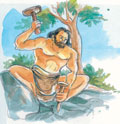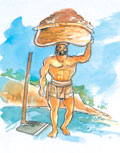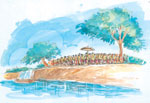 1.
Wherever King Dutugemunu camped on his way, a number of youth
joined the army. They had mastered the art of warfare and wanted
to fight for the country. By the time the king reached Kahatapitiya,
the strength of the army had increased immensely. They were impatiently
awaiting the big day. After surveying the numbers of his army,
the king thought, “This army is nothing, when compared to
the army of the Tamils. Nevertheless, now that they have joined
to fight for the cause of their country and religion, they could
be used, at least, to repair the temples destroyed by the enemy.
If the will is strong, the task ahead would be simple”.
1.
Wherever King Dutugemunu camped on his way, a number of youth
joined the army. They had mastered the art of warfare and wanted
to fight for the country. By the time the king reached Kahatapitiya,
the strength of the army had increased immensely. They were impatiently
awaiting the big day. After surveying the numbers of his army,
the king thought, “This army is nothing, when compared to
the army of the Tamils. Nevertheless, now that they have joined
to fight for the cause of their country and religion, they could
be used, at least, to repair the temples destroyed by the enemy.
If the will is strong, the task ahead would be simple”.
 2.
After spending a peaceful night at Kahatapitiya, the king woke
up very early the next day and worshipped the relics. He then
offered breakfast to five-hundred monks. When everybody had finished
the morning meal, the king, accompanied by his army, began his
march to Mahiyangana. By this time, Mahiyangana was under Tamil
rule and they had erected a fortress there. The guard at the fort
was fortified under a commander named Chatra and there was an
army of thirty-two thousand soldiers under him.
2.
After spending a peaceful night at Kahatapitiya, the king woke
up very early the next day and worshipped the relics. He then
offered breakfast to five-hundred monks. When everybody had finished
the morning meal, the king, accompanied by his army, began his
march to Mahiyangana. By this time, Mahiyangana was under Tamil
rule and they had erected a fortress there. The guard at the fort
was fortified under a commander named Chatra and there was an
army of thirty-two thousand soldiers under him.
 3.
The Sinhala army camped close to this fort and started attacking
the fort, the following day. The enemy retaliated and the battle
lasted for a long time. Finally, the Sinhala army was victorious.
They were able to kill most of the soldiers in the enemy army.
Mahiyangana was brought under the control of the king. King Dutugemunu
then entrusted his army with the reconstruction work there.
3.
The Sinhala army camped close to this fort and started attacking
the fort, the following day. The enemy retaliated and the battle
lasted for a long time. Finally, the Sinhala army was victorious.
They were able to kill most of the soldiers in the enemy army.
Mahiyangana was brought under the control of the king. King Dutugemunu
then entrusted his army with the reconstruction work there.
4.
First of all, the Mahiyangana chetiya was renovated. The king
himself was present at the site, supervising the work. There is
an interesting anecdote coming down from legend. According to
this legend, the king was in the habit of chewing betel and he
had a special male-servant to supply him with the betel. This
man was from the village of Kiripattiya. He had to supply betel
to the king four times a day and the others had nicknamed him
‘Bulatha’ (Bulath, meaning betel). Whenever he had
a little free time, he walked about in the neighbourhood. On one
of his rounds, he noticed a wonderful sight. He saw a little valley,
between two mountains and there was a stream flowing along. He
thought it was an ideal place to build a tank.
 5.
During his leisure time, this man started to work on the tank.
He was a very strong man. The mammoty, the baskets and all other
implements that he used for this purpose, were said to be extra
big and very heavy. However, he had been able to handle them.
Without anybody getting to know, the work on the tank progressed.
His wife brought meals to the site.
5.
During his leisure time, this man started to work on the tank.
He was a very strong man. The mammoty, the baskets and all other
implements that he used for this purpose, were said to be extra
big and very heavy. However, he had been able to handle them.
Without anybody getting to know, the work on the tank progressed.
His wife brought meals to the site.
6.
Now Bulatha’s wife had to take a long route when she brought
the meals. She thought of building a pathway to reduce the distance.
When Bulatha noticed this, he also helped her. As the construction
work of Mahiyangana Chetiya was nearing completion, Bulatha’s
tank and the short-cut made by his wife were both completed. They
were very careful to keep all this a secret.
7.
The pinnacle laying ceremony of the chetiya was organized. At
the auspicious time the pinnacle was unveiled. Bulatha then went
to the king, worshipped him and said, “O’ King, I
too did something for the benefit of the people. Would you please
come and see it?” The king readily agreed and went with
his men. The king was quite surprised and asked him how he found
the time to do all this. Bulatha replied that whenever he had
a little time to spare, he attended to this work. “What
a great tank!”, exclaimed the king.
8.
Bulatha then told the king that his wife too did something great.
When the king wanted to know what it was, he was taken to the
steps. It happened to be a short-cut from Udu-dumbara to Veragantota,
and consisted of thousands of stone steps. It came to be known
as ‘Gal-padi-hela’. The tank was named ‘Sora-bora-wewa’.
As none of the chronicles mentions this episode, this is pure
legend.
 1.
Wherever King Dutugemunu camped on his way, a number of youth
joined the army. They had mastered the art of warfare and wanted
to fight for the country. By the time the king reached Kahatapitiya,
the strength of the army had increased immensely. They were impatiently
awaiting the big day. After surveying the numbers of his army,
the king thought, “This army is nothing, when compared to
the army of the Tamils. Nevertheless, now that they have joined
to fight for the cause of their country and religion, they could
be used, at least, to repair the temples destroyed by the enemy.
If the will is strong, the task ahead would be simple”.
1.
Wherever King Dutugemunu camped on his way, a number of youth
joined the army. They had mastered the art of warfare and wanted
to fight for the country. By the time the king reached Kahatapitiya,
the strength of the army had increased immensely. They were impatiently
awaiting the big day. After surveying the numbers of his army,
the king thought, “This army is nothing, when compared to
the army of the Tamils. Nevertheless, now that they have joined
to fight for the cause of their country and religion, they could
be used, at least, to repair the temples destroyed by the enemy.
If the will is strong, the task ahead would be simple”. 2.
After spending a peaceful night at Kahatapitiya, the king woke
up very early the next day and worshipped the relics. He then
offered breakfast to five-hundred monks. When everybody had finished
the morning meal, the king, accompanied by his army, began his
march to Mahiyangana. By this time, Mahiyangana was under Tamil
rule and they had erected a fortress there. The guard at the fort
was fortified under a commander named Chatra and there was an
army of thirty-two thousand soldiers under him.
2.
After spending a peaceful night at Kahatapitiya, the king woke
up very early the next day and worshipped the relics. He then
offered breakfast to five-hundred monks. When everybody had finished
the morning meal, the king, accompanied by his army, began his
march to Mahiyangana. By this time, Mahiyangana was under Tamil
rule and they had erected a fortress there. The guard at the fort
was fortified under a commander named Chatra and there was an
army of thirty-two thousand soldiers under him. 3.
The Sinhala army camped close to this fort and started attacking
the fort, the following day. The enemy retaliated and the battle
lasted for a long time. Finally, the Sinhala army was victorious.
They were able to kill most of the soldiers in the enemy army.
Mahiyangana was brought under the control of the king. King Dutugemunu
then entrusted his army with the reconstruction work there.
3.
The Sinhala army camped close to this fort and started attacking
the fort, the following day. The enemy retaliated and the battle
lasted for a long time. Finally, the Sinhala army was victorious.
They were able to kill most of the soldiers in the enemy army.
Mahiyangana was brought under the control of the king. King Dutugemunu
then entrusted his army with the reconstruction work there. 5.
During his leisure time, this man started to work on the tank.
He was a very strong man. The mammoty, the baskets and all other
implements that he used for this purpose, were said to be extra
big and very heavy. However, he had been able to handle them.
Without anybody getting to know, the work on the tank progressed.
His wife brought meals to the site.
5.
During his leisure time, this man started to work on the tank.
He was a very strong man. The mammoty, the baskets and all other
implements that he used for this purpose, were said to be extra
big and very heavy. However, he had been able to handle them.
Without anybody getting to know, the work on the tank progressed.
His wife brought meals to the site.